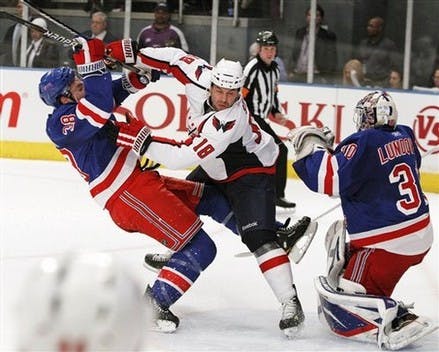Second line candidates: Marco Sturm

The reaction by many Canucks fans to the acquisition of free-agent forward Marco Sturm was a combination of bewilderment, frustration and resignation.
Sturm is not the skilled power forward to team up with Ryan Kesler that the local media had been calling for, but there are very few NHLers that fit that bill and players with those intangibles tend to be held onto. There’s a reason the St. Louis Blues locked up David Backes for five years and $22.5 million.
Sturm is the latest in a long line of veterans, with something to prove, to be offered a contract by Mike Gillis. The Canucks’ GM gave Raffi Torres, Kyle Wellwood, Mathieu Schneider and Pavol Demitra a chance to revive their respective careers in Vancouver, with mixed results. The Canucks are banking on the fact that the 32-year-old Sturm will be motivated to show he can still play and remain healthy in order to earn another NHL contract in 2012-13.
Strengths:
The native of Dingolfing, Germany has amassed 239 goals and 482 points in 890 games over 13 seasons, and is an eight-time 20 goal scorer. In 2009-10, Sturm’s last season of 70 or more games, he tallied 22 goals and 15 assists for the Boston Bruins. Sturm has a propensity for late game heroics, as his 84 career goals in the last five minutes of games is more than 2011 Hart Trophy winner Daniel Sedin. The left winger is a proven secondary scoring option, playing on a second line with the San Jose Sharks for the majority of eight seasons before being jettisoned to Boston as part of the Joe Thornton trade. As a Bruin, Sturm played on a scoring line with Patrice Bergeron and Brad Boyes and slotted onto the first line with Marc Savard and Milan Lucic for parts of the 2009-10 season.
Sturm has played the majority of his career as a top-six winger and certainly has the ability to be an above-average second line player. As Jonathan Willis stated in his piece on point totals, the scoring range for most second-line players in 2010-11 was between 34 and 49 points. Sturm has averaged 25 goals and 46 points in his last eight seasons in which he’s played at least 60 games.
Sturm, the 21st overall pick in 1996, has produced solid possession statistics in recent years with a corsi rating of 9.39 and 9.86 in his last two seasons in which he’s played more than 70 games. Playing top-six minutes for most of his career, Sturm has maintained a good, albeit unspectacular, quality of competition rate.
Versatility is Sturm’s calling card, as the left winger brings a solid two-way game to the ice. He’s been a plus player in 10 of 13 NHL seasons. Kesler’s line is often matched up with the opposition’s top players and with Sturm’s defensive acumen he would not be out of place playing with the American center against top offensive units.
Sturm is also a very effective special-teams player. In his last five seasons of relative health, he has a time-on-ice per game average of 1:44 on the penalty kill and 3:24 on the power-play. The German-born winger has scored 10 power-play goals three times in his career and has tallied 18 career shorthanded goals. If the Canucks front-load their first power-play unit again next season, Sturm would be a welcome addition to the seldom used second-unit.
Weaknesses:
With the exception of his first six NHL seasons, Sturm has been plagued by a myriad of injuries. He’s played 80 games just three times in his career. The winger has missed 116 in the past three seasons, with a torn ACL and MCL and has undergone two major knee surgeries. Prior to that, Sturm suffered a concussion, an eye injury and a broken leg. The knee injuries are the most worrying, as they’ve not only kept Sturm out of the lineup but also hampered his skating ability. Sturm was one of the league’s quickest players, he finished second to Peter Bondra in the fastest skater competition at the 1999 NHL All Star Game, but has been slowed down by the physical damage he’s taken over the years.
And according to Los Angeles Kings head coach Terry Murray, the injuries have taken a toll on Sturm’s work ethic and conditioning. Murray called out Sturm for his inability to contribute after he was acquired from Boston midway through the 2010-11 season. Needless to say, it’s essential that Sturm uses the off-season to sharpen his fitness. The veteran forward would certainly benefit from a full training camp, something he missed out on last season.
Sturm’s playoff statistics leave a lot to be desired. In nine playoff games with Washington in 2010-11, his corsi rating was abhorrent despite starting 55 percent of his shifts in the offensive zone. He has just nine goals in 61 post-season games. If Gillis is hoping that Sturm will be a playoff performer to complement Kesler on the second line, he could be in for a dissapointment.
Verdict:
While fans of the Canucks might not be brimming with enthusiasm about the journeyman’s debut with the team, Marco Sturm is a legitimate top-six forward who, if healthy, can contribute in several ways.
He is the odds-on favourite to slot onto Kesler’s left side for at least the first two months of the season while Mason Raymond rehabilitates from the fractured vertebrae he sustained in the Stanley Cup Finals. Sturm could hold onto that second line left wing role if he’s able to stay healthy.
Of all Vancouver’s skaters competing for a spot on the second line, Sturm has the most experience playing top-six minutes. Samuelsson was predominately a third line player in Detroit, while Higgins and Raymond have played both second and third line minutes in their relatively short careers. Moreover, Sturm has the two-way abilities to play with Kesler against the offensive dynamos on the opposition’s top lines.
Recent articles from Herbert Vasiljevs





